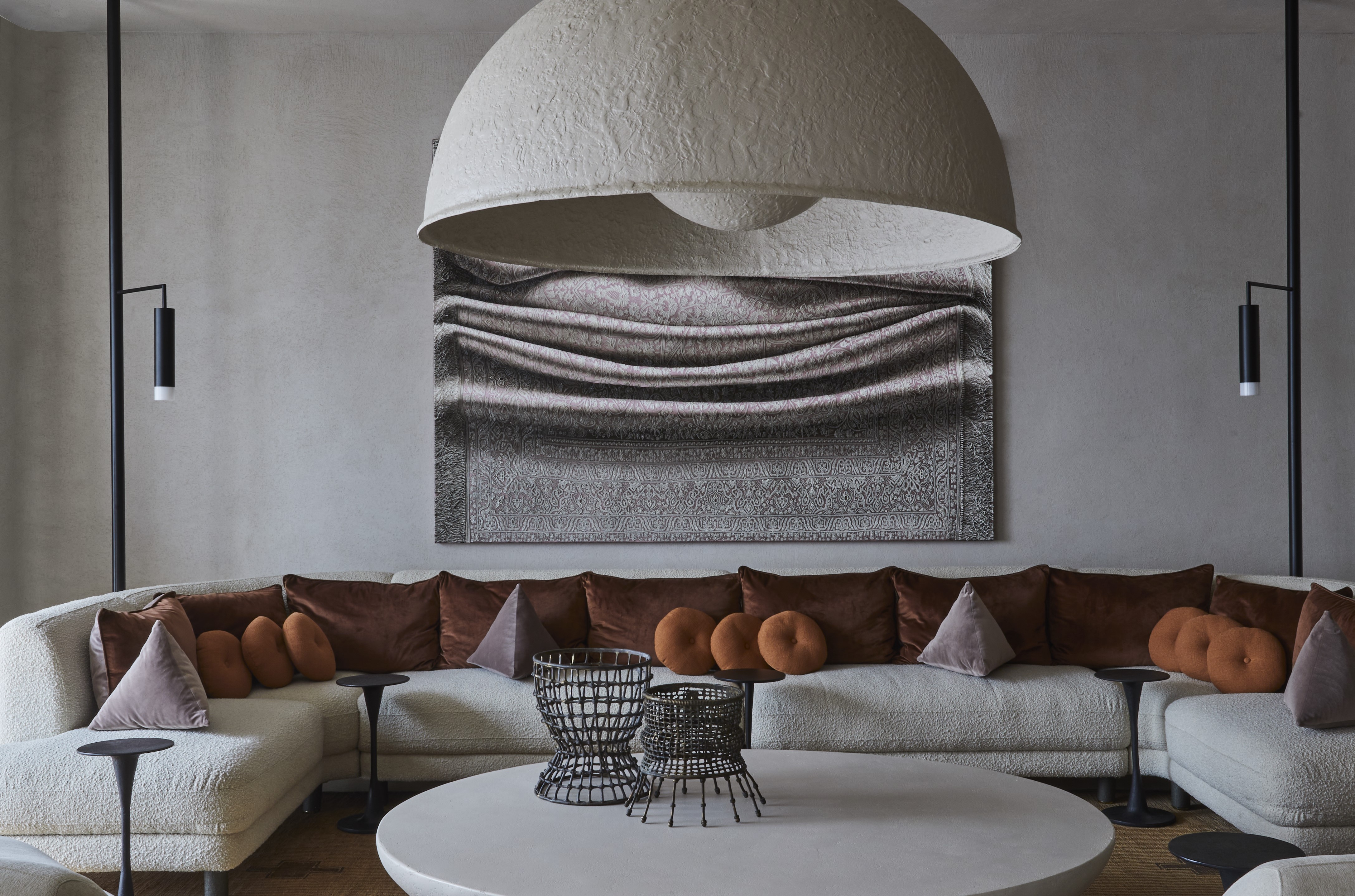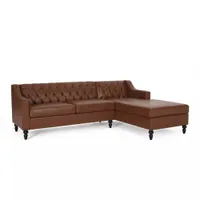Is a curved sofa a good idea? Design experts on the pros and cons of this massive design trend
Experts weigh in on this unique shape, and whether it is actually as good as it looks for the living room


You can't have escaped curved sofas a big design trend this year. Designers like Bryan O'Sullivan, Jonathan Adler, Brigette Romanek and more have set the decor agenda with them. They're chic, they're ideal for drawing people together, for creating little conversational pools within a space. But are they as good an idea as they look?
In fact, they're not for every living room. 'Curved sofas aren't TV-watching sofas,' Bryan O'Sullivan of Bryan O'Sullivan Studio says. 'You can't lounge across them. They're cocktail couches instead.'
So should you have one? Are they right for you? Read on and take notes.

Aditi is a homes writer and editor with several years of experience. Her articles, backed by expert insights, offer suggestions aimed at helping readers make the best home design choices. For this article, she spoke to top experts from the industry to understand the importance of a curved sofa.
The Pros of curved sofas
There is a real elegance to curved sofas. They help to make a room feel like a cocoon, bringing people into its middle, focussing the design on the center of the space. And they have a charming, mid-century vibe, which links to their original conception.
'Curved sofas are having a massive resurgence,' says says Samantha Wilson, interior designer and founder of Collection Noir. 'They first become popular in the 1950s when Vladimir Kagen created his Serpentine sofa for an art collector client who required his guests to see his full collection from all vantage points. Since then, and thanks to this iconic piece and subsequent iterations, designers have been given a little more creativity when designing a space.'
When thinking of a sofa vs a sectional, the former with its rounded and curved form can actually work as a sectional at times, accommodating more people and functions than a standard sofa.

Curved sofas are perfect for small living rooms. They create ample space around and in front of them, thereby expanding the circulation area in the room. 'Providing more seating, they function as a stylish piece that invigorates a space more than a modular sofa would,' says Samantha. ''The simplicity of the design can be transformed time and time again by mixing up soft furnishings, occasional chairs, and even the interior styling of a room, making it an everlasting, timeless piece.'
The Livingetc newsletters are your inside source for what’s shaping interiors now - and what’s next. Discover trend forecasts, smart style ideas, and curated shopping inspiration that brings design to life. Subscribe today and stay ahead of the curve.
Serpentine sofa, Anthropologie
When it comes to where's the best place to buy a couch, Anthro is up there. As snaky as its name suggests, and as inspired by the Kagan original as any brand can be, this seductive sofa arches across your living room layout smoothly.
They can be placed in the middle of the room

And curved sofas makes for intriguing living room layouts.
'If you have a spacious room, then the perfect setting for a curved sofa is to have it floating in the center of the room,' says Samantha. 'Its sofa dimensions allow the beautiful curves to be exposed and will add an element of playfulness to the room. Even if space is at a premium, adding the right curved sofa can help soften the edges and create a sense of grandeur and openness. They also help to fill a large space in a considered and stylish way, adding definition in a beautifully subtle and effortless way.'
'For me, I love the way a curved sofa can center a room and immediately create a sense of understated luxury and calm, whilst paying home to mid-century design,' says Samantha. 'The subtle infusion of the curve instantly lifts a space and becomes a timeless yet versatile setting. Lastly, it's a great way to create a luxurious look and feel without maxing out the budget.'
Creates a cocooning look

A curved sofa adds tremendously to a cozy living room look, and due to its embracing form, lends the most charming, welcoming, and restful visual. It's the kind of piece that works in all types of interior design schemes as well.
'From a physiological standpoint, our brains are inherently drawn to organic shapes such as circular forms and curved lines, so the soft curves of the sofa create a sense of calm, and safety and help cocoon you,' says Samantha. 'Allowing for unique furniture layouts when faced with tricky designs, they are ideal for dealing with an odd-shaped room. The placement of a curved sofa can help with the once unusable area of living space.'
'We included ample seating that would be appropriate to both entertain business associates in a formal setting, and friends and family in a more casual and relaxed manner, so we chose more formal armchairs for meetings and then incorporated an oversized sectional sofa for the family to lounge on,' says Charu Gandhi, director at Elicyon. 'The curved sofa works in tandem with other pieces and creates a smaller ‘space within a space' that gives various options for day-to-day living and entertaining.'

The curved sofa can create a luxury living room vibe; a great place to perch while you sip your martini. While it's elegant, it is still loungy and is inherently a piece that will stop everyone in their tracks. Due to its make, it allows the users to be able to sit in a semi-circular fashion, and comfortably face the people they're talking to.
'Curved sofas, in particular, allow for a more intimate social setting, whilst maintaining a sense of relaxed luxury,' says Samantha. 'Many renowned designers have been heavily influenced by curved furniture throughout the decades, but it's the 1950s waves and curves that maintain their leading position in the design world, with the details, colors, and silhouettes allowing them to reemerge in full force.'
The cons of a curved sofa
As mentioned at the top of the piece, curved sofas don't necessarily invite you to lounge around on them. Because of their shape, you can't recline across them and watch a movie, huddled under a blanket.
They also can lead to a bit of dead space. 'For an elegant living room, you do have to be careful, as if you do not consider the overall design of a room correctly, then a curved sofa can create pockets or holes in a space,' says Samantha.
Equally, the mass market hasn't been able to create them affordably yet, so they're not the most affordable way to design a living room. 'They can be a lot more expensive than a traditional sofa, and if you are someone who likes to rearrange your furniture and revive the space from time to time, then a curved sofa won't give you that same flexibility,' Samantha says.
In family rooms you may prefer a sectional sofa as a more practical option. While it does have sharp edges, it has many qualities of a curved sofa. Yet it can sit flush against the wall, maximizing space, and people can lie across it more easily.
'Sectionals can double your seating, and make the space feel cozy and inviting,' says interior designer Mary Patton. 'You can stretch out with plenty of room for guests and efficiently use all the space you have.'

Tufted Chaise Sectional from Target
This dark brown sectional sofa is a beautiful, tufted design that can fit well inside a small living room. It offers soft visuals and adds an elegant touch to the space.
The verdict on curved sofas
It seems curved sofas are going nowhere as far as living room trends for 2023. We're continuing to see them in some of the best homes by the best designers. Choose one if you're creating a space for entertaining, if you're not planning to watch movies on it, and if you're not precious about maximizing every inch of floor space.

Aditi Sharma Maheshwari started her career at The Address (The Times of India), a tabloid on interiors and art. She wrote profiles of Indian artists, designers, and architects, and covered inspiring houses and commercial properties. After four years, she moved to ELLE DECOR as a senior features writer, where she contributed to the magazine and website, and also worked alongside the events team on India Design ID — the brand’s 10-day, annual design show. She wrote across topics: from designer interviews, and house tours, to new product launches, shopping pages, and reviews. After three years, she was hired as the senior editor at Houzz. The website content focused on practical advice on decorating the home and making design feel more approachable. She created fresh series on budget buys, design hacks, and DIYs, all backed with expert advice. Equipped with sizable knowledge of the industry and with a good network, she moved to Architectural Digest (Conde Nast) as the digital editor. The publication's focus was on high-end design, and her content highlighted A-listers, starchitects, and high-concept products, all customized for an audience that loves and invests in luxury. After a two-year stint, she moved to the UK and was hired at Livingetc as a design editor. She now freelances for a variety of interiors publications.

